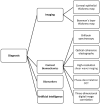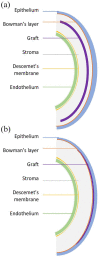Advances in the diagnosis and treatment of keratoconus
- PMID: 34263132
- PMCID: PMC8246497
- DOI: 10.1177/25158414211012796
Advances in the diagnosis and treatment of keratoconus
Abstract
Keratoconus had traditionally been considered a rare disease at a time when the imaging technology was inept in detecting subtle manifestations, resulting in more severe disease at presentation. The increased demand for refractive surgery in recent years also made it essential to more effectively detect keratoconus before attempting any ablative procedure. Consequently, the armamentarium of tools that can be used to diagnose and treat keratoconus has significantly expanded. The advances in imaging technology have allowed clinicians and researchers alike to visualize the cornea layer by layer looking for any early changes that might be indicative of keratoconus. In addition to the conventional geometrical evaluation, efforts are also underway to enable spatially resolved corneal biomechanical evaluation. Artificial intelligence has been exploited in a multitude of ways to enhance diagnostic efficiency and to guide treatment. As for treatment, corneal cross-linking treatment remains the mainstay preventive approach, yet the current main focus of research is on increasing oxygen availability and developing new strategies to improve riboflavin permeability during the procedure. Some new combined protocols are being proposed to simultaneously halt keratoconus progression and correct refractive error. Bowman layer transplantation and additive keratoplasty are newly emerging alternatives to conventional keratoplasty techniques that are used in keratoconus surgery. Advances in tissue engineering and regenerative therapy might bring new perspectives for treatment at the cellular level and hence obviate the need for invasive surgeries. In this review, we describe the advances in the diagnosis and treatment of keratoconus primarily focusing on newly emerging approaches and strategies.
Keywords: advances; diagnosis; keratoconus; treatment.
© The Author(s), 2021.
Conflict of interest statement
Conflict of interest statement: The authors declared no potential conflicts of interest with respect to the research, authorship, and/or publication of this article.
Figures



Similar articles
-
Collagen cross-linking using riboflavin and ultraviolet-a for corneal thinning disorders: an evidence-based analysis.Ont Health Technol Assess Ser. 2011;11(5):1-89. Epub 2011 Nov 1. Ont Health Technol Assess Ser. 2011. PMID: 23074417 Free PMC article.
-
[KERATOCONUS: DIAGNOSIS AND INNOVATIONS].Harefuah. 2025 Jan;164(1):39-45. Harefuah. 2025. PMID: 39931019 Review. Hebrew.
-
Intrastromal corneal ring implants for corneal thinning disorders: an evidence-based analysis.Ont Health Technol Assess Ser. 2009;9(1):1-90. Epub 2009 Apr 1. Ont Health Technol Assess Ser. 2009. PMID: 23074513 Free PMC article.
-
Corneal cross-linking (CXL) combined with refractive surgery for the comprehensive management of keratoconus: CXL plus.Indian J Ophthalmol. 2020 Dec;68(12):2757-2772. doi: 10.4103/ijo.IJO_1841_20. Indian J Ophthalmol. 2020. PMID: 33229651 Free PMC article. Review.
-
Corneal Cross-Linking: An Example of Photoinduced Polymerization as a Treatment Modality in Keratoconus.Polim Med. 2016 Jan-Jun;46(1):89-94. doi: 10.17219/pim/65010. Polim Med. 2016. PMID: 28397423 Review.
Cited by
-
MicroRNA Profiling in the Aqueous Humor of Keratoconus Eyes.Transl Vis Sci Technol. 2022 Dec 1;11(12):5. doi: 10.1167/tvst.11.12.5. Transl Vis Sci Technol. 2022. PMID: 36472881 Free PMC article.
-
Harnessing Corneal Stromal Regeneration for Vision Restoration: A Comprehensive Review of the Emerging Treatment Techniques for Keratoconus.Cureus. 2024 Sep 21;16(9):e69835. doi: 10.7759/cureus.69835. eCollection 2024 Sep. Cureus. 2024. PMID: 39435192 Free PMC article. Review.
-
Studying the effect of keratoconus severity on the accuracy of intraocular lens power calculation using newer keratoconus-specific formulas.BMC Ophthalmol. 2025 Apr 17;25(1):219. doi: 10.1186/s12886-025-04040-9. BMC Ophthalmol. 2025. PMID: 40247207 Free PMC article.
-
Clinical performance of a custom-designed soft contact lens in patients with keratoconus and intolerance to rigid contact lenses.Jpn J Ophthalmol. 2022 Jul;66(4):350-357. doi: 10.1007/s10384-022-00924-1. Epub 2022 Jun 7. Jpn J Ophthalmol. 2022. PMID: 35670923
-
Prevalence and demographic profile of keratoconus among high school students in Kenya.Int Ophthalmol. 2025 Jan 9;45(1):21. doi: 10.1007/s10792-024-03370-9. Int Ophthalmol. 2025. PMID: 39779526 Free PMC article.
References
-
- Kennedy RH, Bourne WM, Dyer JA. A 48-year clinical and epidemiologic study of keratoconus. Am J Ophthalmol 1986; 101: 267–273. - PubMed
-
- Ma JX, Wang L, Weikert MP, et al.. Evaluation of the repeatability and reproducibility of corneal epithelial thickness mapping for a 9-mm zone using optical coherence tomography. Cornea 2019; 38: 67–73. - PubMed
-
- Pircher N, Beer F, Holzer S, et al.. Large field of view corneal epithelium and bowman’s layer thickness maps in keratoconic and healthy eyes. Am J Ophthalmol 2020; 209: 168–177. - PubMed
-
- Matalia H, Francis M, Gangil T, et al.. Noncontact quantification of topography of anterior corneal surface and bowman’s layer with high-speed OCT. J Refract Surg 2017; 33: 330–336. - PubMed
-
- Chandapura R, Salomão MQ, Ambrósio R, Jr, et al.. Bowman’s topography for improved detection of early ectasia. J Biophotonic 2019; 12: e201900126. - PubMed
Publication types
LinkOut - more resources
Full Text Sources
Research Materials

